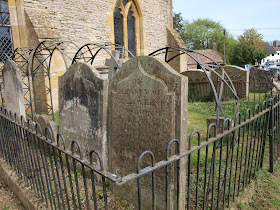After leaving Fladbury (see Part 1) we stopped off very briefly in Evesham. When
we spotted this shop it was time to stock up on pasties for tea.
Spotted this interesting looking building as we drove out - will certainly go back to Evesham one day for a proper look round.
D*
The final village we visited was the timeless 17th century village of Bretforton. It has been used in the making of several films and tv shows, for example Martin Chuzzlewit, Robbie Coltrane's B road Britain, The One Show and the BBC period drama Land Girls.
Corner Cottage
Cottages near the church and the Fleece Inn
St Leonard's Church is a Grade 1 Listed building and dates from the late 13th century with Medieval and later additions. The Chancel was consecrated in 1295.
Thatch Fox and Boxing Hares
*D
*D
I managed a very quick tour of the church and churchyard. I couldn't find a general guide to the history of the church but they did have an interesting booklet on the church's stained glass windows.
This beautiful modern stained glass window was designed and made by Keith Brettle in 2010. The left panel shows The Church of St Leonard, Bretforton Silver Band and Bretforton First School and the panel on the right shows The Fleece Inn, The Royal British Legion and "Asparagus Officinalis" Gras.
This window depicts scenes to illustrate Psalm 1.
This rounded trefoil window dates from ~1896 and shows Mary, Joseph and Baby Jesus travelling to Egypt to escape persecution.
This window dates back to ~1901 and shows Christ being baptised by John the Baptist.
The East window was made by Frederick Preedy (1820-1898) who was a well known church architect and designer of stained glass. He was born in the nearby parish of Offenham and worked first in Worcester then London. This is a copy of the original window which was removed in 1855.
The panel on the left of this window shows St Leonard to whom the church was rededicated in 1295 and the panel on the right shows the Virgin Mary.
This late 19th century window shows the Last Supper.
A few other photos from around the church
The base and bowl of the font may be 12th century.
I initially missed the medieval glass in the church and only found out about it when reading the booklet while having a late lunch in the pub so sent D in with the Camera Bridge to use the zoom lens to get a couple of photos.
Medieval glass in a quatre-foil head showing a flower pattern and a face.
*D
Medieval glass sowing the head of a winged angel
The churchyard was full of old tombs and gravestones.
An interesting face carved on this one.
I am intrigued as to the purpose of the metal arches in front of these graves. Does anyone have any idea please what they might be for?
This gravestone has interesting carvings - I can make out what looks like a church on the left with a winged figure to the right and a figure with what looks like rays of the sun surrounding its head rising from an open tomb or urn? together with what may be foliage. Unfortunately, I didn't take a photo of the whole gravestone so have no idea whether the inscription on it gave any clues to the purpose of the carvings.
An old and broken tomb
18th century gravestones to the Timbrill family
Garlic mustard flowering near a yew tree.
Tombstone for Thomas Ashu with his profession (Apothecary) mentioned.
This simple gravestone just has the initials TM and the date 1727 and what looks to me like the carving of a butterfly.
Opposite the church was the ancient Fleece Inn now owned by the National Trust and home to the famous Asparagus Auctions.
The building was built around 1425, in Chaucer's time, originally as a long house by a farmer called Byrd. The same family owned the property for hundreds of years. In 1848 it first opened as an Ale House. The last private owner of the pub was a Miss Lola Taplin, who was a direct descendant of the Farmer Byrd who built the house. She
passed away in 1977 and left the inn to the National Trust. A fire in February 2004 severely damaged the building when a chimney fire led to the thatched roof catching fire. Most of the antiques were rescued and the pub has since been carefully restored.
*D
*D
Time for a pint and a late lunch - vegetarian and non-veggie versions shown!
The Pewter Room is the oldest part of the pub and contains a pewter collection which has been on display for the last 300 years. Witch circles were originally put in this room to prevent witches coming into the room via the chimneys.
Sorry for so many photos and such a long post! A final photo from the pub of a lichen covered stone toadstool.
I would definitely like to go back to Bretforton as there was so much more of the village, with cotswold type stone buildings, to explore but we had run out of time for this visit.
*D photos taken by D with the Canon Bridge SX50 HS
Reference:
Booklet entitled "The Stained Glass of St Leonard, Bretforton"






















































